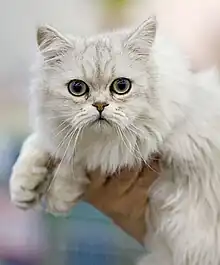Asian cat
The Asian or Asian group, is a cat breed similar to the European Burmese but in a range of different coat colours and patterns.[2] Long-haired Asians of all varieties are called Tiffanies. Asians are grouped in section 5 at cat shows.
| Asian | |
|---|---|
.jpg.webp) Cinnamon ticked Asian Tabby | |
| Origin | Developed in the United Kingdom |
| Breed standards | |
| GCCF | standard |
| LOOF | standard |
| Other | LCWW standard |
| Notes | |
The Asian cat is sometimes incorrectly referred to as the 'Malayan' cat, however this refers to the blue, chocolate and lilac varieties of Burmese cats in CFA during the years 1974 to 1984.[1] | |
| Domestic cat (Felis catus) | |
Origin
History
The breed was accidentally developed in the United Kingdom, starting with a litter of 4 kittens resulting from a mismating of a chinchilla Persian stud, Jamari Sanquist, and a lilac European Burmese queen, Bambino Lilac Faberge, bred in 1981 by Baroness Miranda von Kirchberg.[3]
Bombay
The solid black Bombay under the Asian Self-category has a slightly different origin, but is also developed in the UK. In the early 1980's, the resulting kittens of three mismatings of European Burmese with black domestic short-haired cats were developed into the British-type Bombay.[4]
Additionally, there exist another variant of the Bombay cat, the American-type Bombay developed in the United States. American-type Bombays were developed by crossbreeding sable American Burmese and black American Shorthair cats,[5][6] to produce a cat of mostly Burmese type, but with a sleek, panther-like black coat and exclusively with bright copper-golden eyes.[6] For the British-type Bombay golden eyes are preferred, but yellow through to green is acceptable, with the preference given to greater depth of colour.[7][8]
Breed recognition
After the first litter of kittens were born in 1981, breeders believed the kittens showed potential to become their own breed. Early breeders decided the phenotype of the kittens was to be exactly the same as the Burmese, but in more colours and varieties. All varieties gained championship status with the GCCF in 2003, with the Tiffanie being the last variety to gain it.[9]
Asian group
In appearance, the Asian group is essentially identical to the Burmese breed, but they come in more colours and patterns, and in the case of the Tiffanies (Asian semi-longhairs), longer fur. Smoke is the term used for self/solid coloured silvers (uniform distribution), while shaded and tipped silvers are silver tabbies (distribution in tabby pattern) with 'wide banding'. The Asian group incorporates the:[8]
- Asian Self (self/solid and tortoiseshell),
- Bombay (self/solid black),
- Asian Shaded or Burmilla (silver or golden shaded and tipped),
- Asian Smoke (smoke),
- Asian Tabby (tabby), and
- Tiffanie or Asian (semi-)longhair (longhair variety).
Description
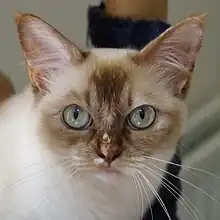
Appearance
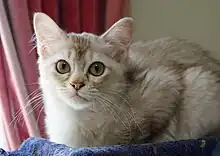
It has a broad, rounded chest and slender legs with a tail of medium length. The pleasantly rounded head has no flattened areas, and there is a visible stop in its profile. This gives the Asian a full-looking face. The round and wide-set eyes come in anywhere from green to yellow.[8] Females are not quite as big as the males.[10] They can weigh anywhere from 3–6 kg (6.6–13.2 lb).[11]
Coat and colours
The short-haired coat of the Asian is fine, satiny and glossy, and can be multiple colours and patterns.[10] Asian Shorthairs are classified in four different varieties: the Asian Self/Tortie (including the Bombay, which is a black Asian Self), the Asian Tabby, the Asian Smoke, and the Burmilla (which is a shaded Asian).[8]
Temperament
Asians are very affectionate and good with children. They share similar traits with the Burmese. They love to play, explore and even enjoy traveling by way of a cat carrier. They are quite a talkative and rather loud cat with an apparent strong will.[11] They enjoy interacting with people, even with strangers.
Reproduction
.jpg.webp)
The females usually go into their first heat at around six to eight months old. Although registered as a separate breed, Asians can produce Burmese phenotype kittens which are known as Asian Variants, these are almost identical to Burmese. Variants cannot be shown in Breed classes but can grace the Pedigree Household Pet Section at GCCF shows. There are over 600 variations on colours and patterns within the breed, some of which are very rare.
Health
Ancestral breeds of the Asian have been known to carry Polycystic Kidney Disease and Progressive retinal atrophy, however, only Burmese Hypokalaemia has been identified in the Asian.[8]
Many Asian breeders and their cats were involved in the research into the disease,[12] and as of 2018 all cats for breeding must either be tested for the gene or be cleared by heritage.
References
- "History of the First European Burmese in CFA". European Burmese Breed Council. Retrieved 22 September 2023.
- Siegal, Mordecai (1983). Simon & Schuster's Guide to Cats. Simon & Schuster. ISBN 0671491709.
- "Our History". Asian cat association. Retrieved 25 March 2023.
- "UK Breed history". www.bombayandasiancatsbreedclub.org. Bombay and Asian Cats Breed Club. Retrieved 2023-09-29.
- Van Zyl, Miezan (2015). The cat encyclopedia - the definitive visual guide. London: Dorling Kindersley. ISBN 9780241234884. OCLC 1322361804.
- "Bombay". CFA.org. Cat Fanciers' Association. Retrieved 29 September 2023.
- "Asian Group Standard of Points - Self". www.bombayandasiancatsbreedclub.org. Bombay and Asian Cats Breed Club. Retrieved 2023-09-29.
- Governing Council of the Cat Fancy. "Asian - Cat Breed". gccfcats.org. Retrieved 8 September 2023.
- "the breed". Asian group cat society. Retrieved 25 March 2023.
- "Asian". Purina. Retrieved 2018-10-17.
- "Malayan - Information, Characteristics, Facts, Names". CatBreedsList.com. Retrieved 2018-10-17.
- "aca Hk". asian cat association. Retrieved 25 March 2023.
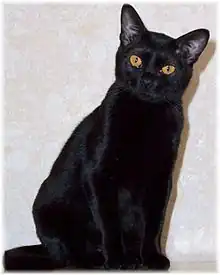
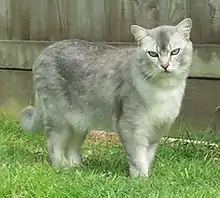
.jpg.webp)
.jpg.webp)
